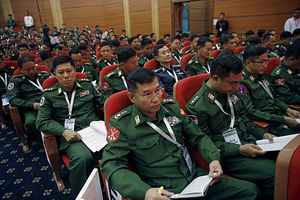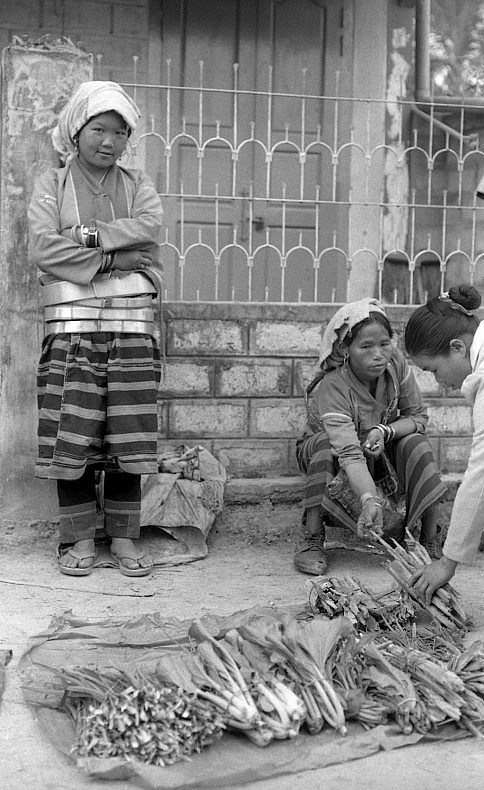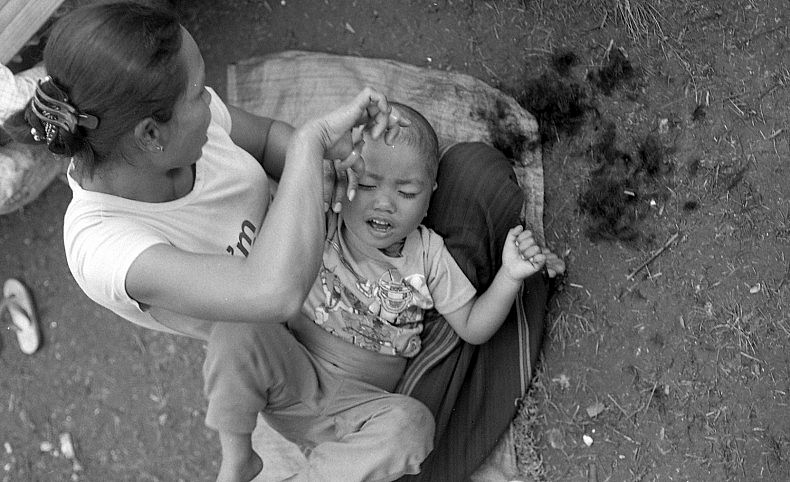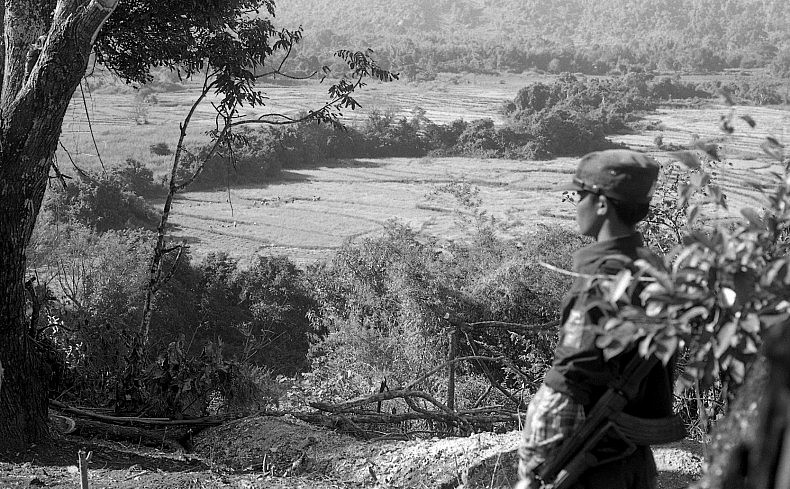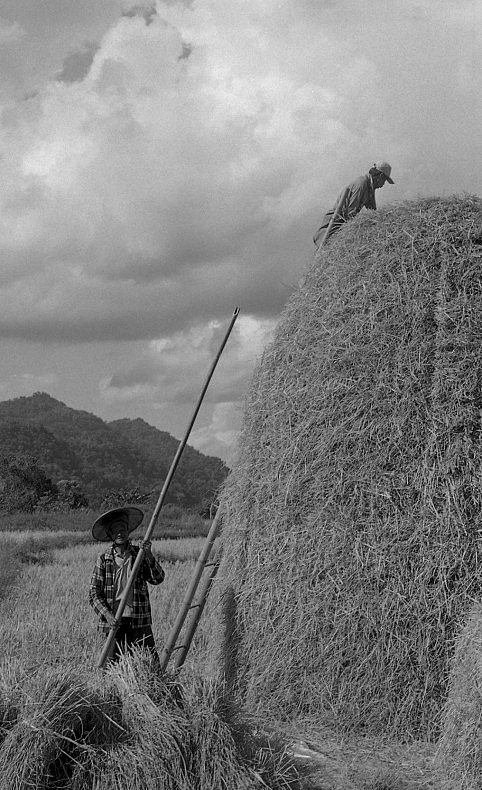At the end of November 2015, I was smuggled through Myanmar army checkpoints beneath a tarp in the back of a car to the Shan State Army-North headquarters in Wan Hai, Shan State, in northern Myanmar. Wan Hai is set amid the rolling terrain of a roughly 1000 meter plateau, punctuated by rugged mountain chains, which stretches north into southwest China and east across Thailand and Laos to the highlands of northern Vietnam. I arrived amid young soldiers bristling with automatic assault rifles and grenade launchers, standing at guard posts or rushing to the front in the backs of pickups trailed by flumes of dust. The central square was filled with local Shan villagers and farmers in their traditional embroidered tunics, and Palaung women with solid silver bands around their waists. My driver, who had been silent and reserved the whole five hour trip from Lashio, broke into a euphoric smile and shook my hand repeatedly, making me realize he might have been jailed or even shot by the Myanmar army, known as the Tatmadaw, if they’d discovered me in his car.
A Tatmadaw offensive against the Shan State Army-North had been underway for almost two months, and the reality of jet and helicopter attacks, artillery shells lobbed into civilian homes and monasteries, and the government army driving villagers from their land stood in stark contrast to the collective euphoria within Myanmar and internationally in the wake of the national election a few weeks before. Although Aung San Suu Kyi’s National League for Democracy (NLD) holds a majority in parliament, by virtue of Myanmar’s 2008 constitution the commander-in-chief stands above the elected government and still controls the army, the police, and the General Administration Department (GAD), the backbone of national administration which exerts political control down to the most localized levels.
The morning after I arrived, I visited a refugee camp that was just days old, a collection of tents pitched next to piles of clothes and cooking pans, where women scraped at the earth with crude mattocks as men worked building bamboo structures. Tatmadaw soldiers had attacked their Shan village for strategic reasons—it sat on a flat space halfway up the flank of a mountain near the front lines. The villagers fled at gunpoint with whatever they could carry, and still looked dazed and bewildered. Old men sat wrapped in blankets by woodfires as children dragged branches to burn from a nearby stand of trees.
The offensive had created 10,000 refugees who had been driven from their land by shelling and air attacks, and their livestock and grain were seized by the Myanmar army in violation of the Geneva Conventions article against a military force seizing the property of civilians during conflict. Reuters reported gang rapes by Tatmadaw soldiers, and while rape and murder of civilians are typically dismissed as “rogue acts” by the government, they have been documented for decades as part of a systemic policy to terrorize and destabilize ethnic minority populations.
Another camp, set up in the courtyard of a Buddhist monastery, was over a month old. Composed of rows of long bamboo platforms with tarp coverings, this camp was a mix of Shan, Palaung, Lisu, and ethnic Chinese. Basic food supplies had come in from local donations, so there was no starvation or malnutrition here, just the ennui and lassitude endemic to refugee camps: whole families sitting dully at the front of their platform spaces, with no work, no property, no engagement with their environment and sustenance, no school for the many children, nothing of what we think of as life. It was the time of rice harvest, and the refugees were stressed and anxious to be away from their fields—without harvesting their rice they would have nothing to eat in the coming year. One woman broke down weeping as she recalled that her husband had gone back to their village to retrieve something, and had been shot dead by Tatmadaw soldiers.
Most days in Wan Hai, I rode along dirt roads in the back of pickup trucks amid a crowd of young soldiers holding automatic weapons, belts of bullets forming Xs across their chests. We passed old Shan women in blue tunics, children playing in yards in front of bamboo houses, pretty girls in intricately embroidered sarongs riding by on motorbikes, and farmers driving water buffalo or cattle down the road.
At a hilltop outpost with dug-out trenches and a .50 caliber anti-aircraft gun, I sat with the commander of the post in the lee of a stupa, a domed Buddhist shrine. We looked across long valleys to far mountain ranges as we lounged in the dappled sun next to the machine guns and boxes of ammunition and the inevitable strewn trash of army camps. Below us, jigsaw-sectioned rice fields spread across the valley floor, with a few farmers out cutting grain with hand sickles, and beyond the fields a government army outpost was dug in on the opposite hill.
At another Shan outpost I met Major Han Kham, who a few days before had led a counterattack that repelled Tatmadaw forces from the tactically critical village Mon Ark, about three miles south of Wan Hai. He sat beneath a sprawling banyan tree near a golden-topped Buddhist temple along with a rubbery old colonel who grinned and lifted up his shirt to reveal a long branching scar that looked like something routed out with an ice saw. Out across the valley floor a work party that included a couple of monks in pink and orange robes was taking advantage of a lull in the fighting to gather dried rice stalks and mound them into tall blonde haystacks.
It was too late in the day for any attacks to be launched by the Tatmadaw, so Major Han Kham said to me, “No fighting today, so let’s have a drink!” He pulled out a bottle whiskey and poured me a shot in a white porcelain tea cup embossed with a blue dragon. He wore an SSA-N cap with a red, green, and yellow SSA-N emblem, combat fatigues, and had grenades lashed to belts on his chest. He offered me a tin of Danish Christmas cookies, saying his wife had sent them up to him from town, and told me about the battle to retake Mon Ark: “They shelled us with mortars, then attacked with helicopter gunships strafing and shooting rockets. We had to withdraw when the air strikes came, and their ground troops took the village. But then we counterattacked, and they had to retreat. We cannot retreat, this is our land; we’re fighting to protect our families.” With families a few miles away, the Shan were fighting for their survival in ways an imported army could never do.
We walked down to the Mong Ark’s ancient stone stupa, a twenty-foot tall stone monument, weathered and bleached with age, listing slightly on a raised mound of earth, surrounded by trees that had been mangled by mortar explosions. Tatmadaw soldiers occupied several hilltops in ridges surrounding the valley, the nearest about 200 meters away. Villagers had fled during the fighting, but some had returned for the day to work. They had brought their animals to graze, and water buffaloes wandered among the pale gold stalks of harvested fields, their cowbells slowly sounding.
During the offensive, there were negotiations in Naypyidaw, the Myanmar capital, for a local truce, in which the government demanded the Shan withdraw from their positions.
Major Sai Su, spokesman of the Shan State Progressive Party, told me in Wan Hai, “Our policy is to defend our territory; we do not attack offensively. The government attacked us, now they demand that we withdraw from our positions. In the past we have given up territory to support peace negotiations, but that did not lead to peace, only to further demands and more attacks by the government.”
Over the past few years, the negotiations for a National Ceasefire Agreement (NCA) followed a similar pattern to these localized talks—ethnic armed groups were invited to sign a binding ceasefire and lay down their arms as a precondition for peace talks. Journalist and Myanmar analyst Bertil Lintner has written of the NCA that “the entire ‘peace process’ is flawed because the government wants to put the cart before the horse by insisting on an agreement … before any political issues have even been discussed.”
Despite proclamations that the ceasefire was a triumph, IHS Jane’s analyst Anthony Davis has said that the government had to display a positive result to justify “tens of millions of dollars being thrown at the ‘peace process’ by Western governments eager to declare Myanmar finally and officially open for business.”
Aung San Suu Kyi had until recently “dismissed the ceasefire… as a pre-election stunt by outgoing President Thein Sein,” (as Reuters put it) but in mid-January she endorsed the process by speaking at the opening of peace talks with the signatories of the NCA. In doing so she may help legitimize a process of government land-grab, as Tatmadaw territorial gains from past offensives have become de facto lines of control, the starting point for negotiations.
The Shan State Army-North, and other ethnic armed groups who have remained unswayed by the military government’s overtures, face difficult and contradictory choices. They are being demanded to sign the “National Ceasefire Agreement,” which is neither national, nor a ceasefire, nor carries any certainty of agreement. This would amount to forfeiting the autonomy which they have defended since it was promised to them on the eve of Burmese independence in 1947 by Aung San Suu Kyi’s father. But if they do not sign the agreement, they are subject to further attacks on both civilian and military targets within their area of control.
Towards the end of my stay in Wan Hai, after two days of rain, a Tatmadaw deserter surrendered to the Shan soldiers at one of the hilltop outposts I’d visited. He was sent down from his own hilltop camp to fetch water, and instead of returning he went over to the Shan side. The Shan gave him some pocket money, asked him a few questions, and told him he could go wherever he wanted—back to his unit if he chose, or home, or elsewhere. During questioning, the deserter said Tatmadaw troops were told the Shan were “wild people”—culturally and genetically inferior, subhuman— and so could be killed and dispersed like animals. As difficult and painful as the reforms of recent years in Myanmar have been, wrestled from a regime notorious for extrajudicial killings, torture, and the jailing of writers and journalists, these reforms might prove to be easier than changing the racial prejudice behind ethnic violence, or changing the realities of administrative structure and ruling power in the government.
By the time I had been at the SSA-N headquarters ten days, the fighting had come to a stalemate. But more than four months after the start of the offensive, the internal refugees it created are still living in limbo, unable to return to their villages, depending on humanitarian donations for survival. Whatever administrative vagaries emerge from the on-going political transition in Myanmar, it’s unlikely that Tatmadaw encroachments during the offensive—diminishments of Shan territory and self-determination, and ultimately of cultural integrity—will be easily reversed. However her role in power-sharing evolves, Aung San Suu Kyi has shown she is willing to sacrifice the interests of marginal groups for the furthering of her own political trajectory.
When I left Wan Hai, I returned to Lashio over dirt roads made nearly impassable by rain, and caught a bus south to Mandalay. Looking out the window of the bus as we descended from the plateau down to the plains, I saw long lines of army transport trucks pass by, heading the other way. They were filled with soldiers holding automatic rifles between their knees, looking out from the canvas covering of the trucks to the world they were passing through, perhaps wondering what lay ahead as they left the haze and heat of the lowlands behind and climbed into the hills.
Scott Ezell is an American poet and multi-genre artist with a background in China and Southeast Asia. For the past five years he has worked on a lyric-documentary writing project about the relationship between state power and indigenous communities in the China-Burma-Lao border region.













